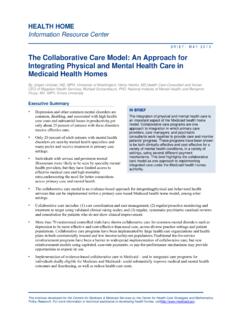Transcription of National Stroke Service Model - NHS England
1 Integrated Stroke delivery Networks National Stroke Service ModelMay 2021 Document name: National Stroke Service Model Programme/Project Name: National Stroke Programme Senior Responsible Owner (SRO): Deb Lowe, Stroke NCDP rogramme Lead: Jodie PowellVersion Date: May 2021 Equality and Health Inequalities Statement:Promoting equality and addressing health inequalities are at the heart of NHS England s values. Throughout the development of the policies and processes cited in this document, we have: Given due regard to the need to eliminate discrimination, harassment and victimisation, to advance equality of opportunity, and to foster good relations between people who share a relevant protected characteristic (as cited under the Equality Act 2010) and those who do not share it.
2 And Given regard to the need to reduce inequalities between patients in access to, and outcomes from healthcare services and to ensure services are provided in an integrated way where this might reduce health Stroke Service Model : Integrated Stroke delivery Networks 3 ContentsForewordPart 1: ISDN composition and core functionsOverviewISDN objectivesKey ambitionsISDN governanceISDN structurePatient and public voice in ISDNsISDN establishmentPart 2: ISDN pathway specificationIntroduction1. Prevention 2. Pre-hospital phase 3. Hyper-acute Stroke care4. Acute Stroke care5. TIA services 6. Rehabilitation 7.
3 Life after Stroke 8. Workforce9. Data and evaluation10. Delivering the NHS Long Term PlanResourcesEvidence across the Stroke pathway455668910111313131416212224313435 363839 ForewordOur Long Term Plan for the NHS recognises the importance of tackling the growing impact of Stroke in England . Integrated Stroke delivery networks are the key vehicle for transforming Stroke care across the country. Using a full-pathway approach , they will prevent thousands of patients suffering a Stroke , through improved diagnosis and access to treatment in 24/7 specialist Stroke units, and increase the availability of high quality rehabilitation and ongoing community care to rebuild patients lives after a Stroke .
4 By driving improvements, we will save half a million lives over the next decade, and give hundreds of thousands of Stroke survivors the chance of a better recovery. Steve PowisNational Medical DirectorNHS England and NHS ImprovementDeborah LoweNational Clinical Director for Stroke NHS England and NHS ImprovementDavid HargrovesGIRFT Clinical Lead NHS England and NHS ImprovementJuliet BouverieChief Executive OfficerStroke Association National Stroke Service Model : Integrated Stroke delivery Networks 4 National Stroke Service Model : Integrated Stroke delivery Networks 5 Part 1: ISDN composition and core functions OverviewThe NHS Long Term Plan (LTP, 2019) set outs the ambitions for the NHS over the next 10 years, identifying Stroke as a clinical priority for the next 10 years.
5 It outlines how we will work with partners to improve Stroke care along the entire pathway, from prevention to rehabilitation. A networked approach based on patient flows will be essential to delivering the NHS Long Term Plan commitments for Stroke : reducing Stroke mortality and disability, as well as the burden Stroke places on families and carers, on the health and social care system and on wider society. For this, integrated Stroke delivery networks (ISDNs) in all areas of England will bring services together to design optimal Stroke pathways, from pre-hospital to early supported discharge (ESD), community specialist Stroke -skilled rehabilitation and life after Stroke support.
6 They will support the delivery of the NHS s seven-day standards for Stroke care;1 and optimise the delivery of safe and effective treatments and rehabilitation to those who have a is strong evidence that investigations and interventions for Stroke , such as brain scanning and thrombolysis, are best delivered as part of a 24/7 networked Service that includes comprehensive and acute Stroke centres (CSC, ASC) of a sufficient size to ensure expertise, efficiency and a sustainable Networked configurations with hyper-acute Stroke units (HASUs) have led to better patient outcomes, including a 5% relative reduction in mortality at 90 days and reduced length of ,4 An evaluation in Northumbria demonstrates the value of networked provision in rural The average annual benefit of National pathway optimisation is estimated to be around 48 million.
7 This takes into account any increased ambulance costs and transition costs, but also a reduction in staff costs and future tariff current evidence from network optimisation was captured before the National commissioning of mechanical thrombectomy. As such, the clinical and cost effectiveness of thrombectomy are not included in the published reviews of network effectiveness. 1 The Keogh Urgent and Emergency Care Review (2013) 2 Access to and delivery of acute ischaemic Stroke treatments: A survey of National scientific societies and Stroke experts in 44 European countries (2018)3 Hunter RM (2013) Impact on clinical and cost outcomes of a centralized approach to acute Stroke care in London: A comparative effectiveness before and after Model .
8 4 Morris S, Hunter RM, Ramsay A, Boaden R, McKevitt C, Perry C, Pursani N, et al (2014) Impact of centralising acute Stroke services in English metropolitan areas on mortality and length of hospital stay: difference-in-differences analysis. BMJ 349: Elameer M, Price C, Flynnn C, Rodgers H (2018) The impact of acute Stroke Service centralisation: a time series evaluation. National Stroke Service Model : Integrated Stroke delivery Networks 6 Thrombectomy has been demonstrated to significantly reduce disability. Stroke networks, with full National coverage, will be essential to enable the delivery of thrombectomy to all patients amenable to this intervention.
9 ISDN objectivesThe overarching aim of an ISDN is to improve the quality of Stroke care for better clinical outcomes, patient experience and patient safety. The ISDN does this by bringing key stakeholders together to facilitate a collaborative approach to improving the entire Stroke pathway and ensure a patient-centred, evidence-based approach to delivering transformational change. Key ambitions Best practice personalised Stroke pathways configured and managed from pre-hospital care onward, including ambulance, thrombectomy, ESD and six-month reviews, and then building to cover the entire pathway from prevention through to life after Stroke .
10 A flexible, future-proofed competency-based Stroke workforce, supported by a skills and capabilities framework and toolkit. A comprehensive dataset that meets the needs of clinicians, commissioners and patients in capturing care quality and improve healthcare quality and experience ISDNs should have the following objectives:OBJECTIVES1: Leadership Provide robust clinical and Stroke programme leadership. This should include medical, nursing and therapy senior leadership to ensure the acute and community pathways are given equal focus. Develop and agree with system leaders a co-ordinated approach to network resourcing, to secure the best outcomes for Stroke Service Model : Integrated Stroke delivery Networks 72: Strategic approach Support integrated care systems (ICSs) to develop a strategic approach to improving local Stroke pathways, in line with the ISDN pathway specification (see Part 2 of this document).

















